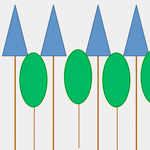
Forest Stand Dynamics and Modeling
Plants, like all living things, grow and change over time. For forests, the time frames are considerably longer than those for many other plants.This module examines how growth and change takes place in spatially continuous groups of trees called forest stands. It explains how the number and size of trees in various types of stands develop over time and describes how stand development, in terms of growth and yield, can be predicted through modeling.
Learning Objectives
After viewing this presentation and relevant support material, users should be able to:
- Understand the terms forest stand and forest stand dynamics.
- Explain the concepts of growing space and growth factors.
- Describe the stages of stand development in even-aged stands.
- Describe how stands of mixed species and multi-age structures differ in their stand development.
- Understand the relationship between growth and yield for even-aged and uneven-aged stands.
- Identify the factors that affect growth and yield of a stand and understand how these factors might be influenced by different silvicultural treatments.
- Understand the basic approaches to modeling growth and yield and how these approaches might impact on the uses of a particular model.
Presenters
Listen to both Presenters respond to the question: How did I get interested in this area of study? by clicking on their photos.
For more information about the two Presenters, click on their names:
Module Resources
Presentations
Dr. Bruce Larson explains how growing space and competition affect the stages of development as tree stands grow and change over time. Stand composition, in terms of the variety of species and ages of trees that make up the stands, also impacts on stand dynamics. Forests comprised of multi-age and multi-species stands require more complex and elaborate management decisions.
![]() Forest Stand Modeling
Forest Stand Modeling
Dr. Peter Marshall describes the quantitative aspect of stand dynamics – growth and yield. Numerous factors such as site quality, species composition, density, stand structure (age), disturbance (biotic and abiotic) and management treatments affect the productivity of a stand. Growth and yield can be modeled using a whole stand versus single tree approach, and an empirical versus mechanistic approach.
Other Resources
- Oliver, C. and Larson, B. 1996. Forest Stand Dynamics. J. Wiley & Sons. 509 p.
- LeMay, V. and Marshall, P. 1990. Forest Mensuration: Course Manual for Forestry 238. Lesson 6: Growth and Yield, p.141 – 164. UBC Access Guided Independent Study; pdf available here
Potential Questions for use by Instructors
- Differentiate between total growing space and available growing space. Explain, using several examples, how disturbances can affect the availability of growing space in a forest stand. What does this have to do with forest stand dynamics?
- What is the relationship between growth and yield?
- Explain how your choice of growth and yield modeling approach would likely vary between predicting growth over a relatively short time in a local area compared to predicting growth over a relatively long time in a broad region.


